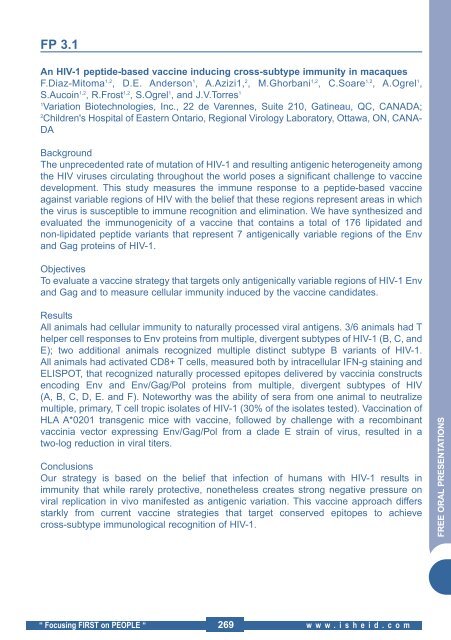final program.qxd - Parallels Plesk Panel
final program.qxd - Parallels Plesk Panel
final program.qxd - Parallels Plesk Panel
You also want an ePaper? Increase the reach of your titles
YUMPU automatically turns print PDFs into web optimized ePapers that Google loves.
FP 3.1<br />
An HIV-1 peptide-based vaccine inducing cross-subtype immunity in macaques<br />
F.Diaz-Mitoma 1,2 , D.E. Anderson 1 , A.Azizi1, 2 , M.Ghorbani 1,2 , C.Soare 1,2 , A.Ogrel 1 ,<br />
S.Aucoin 1,2 , R.Frost 1,2 , S.Ogrel 1 , and J.V.Torres 1<br />
1<br />
Variation Biotechnologies, Inc., 22 de Varennes, Suite 210, Gatineau, QC, CANADA;<br />
2<br />
Children's Hospital of Eastern Ontario, Regional Virology Laboratory, Ottawa, ON, CANA-<br />
DA<br />
Background<br />
The unprecedented rate of mutation of HIV-1 and resulting antigenic heterogeneity among<br />
the HIV viruses circulating throughout the world poses a significant challenge to vaccine<br />
development. This study measures the immune response to a peptide-based vaccine<br />
against variable regions of HIV with the belief that these regions represent areas in which<br />
the virus is susceptible to immune recognition and elimination. We have synthesized and<br />
evaluated the immunogenicity of a vaccine that contains a total of 176 lipidated and<br />
non-lipidated peptide variants that represent 7 antigenically variable regions of the Env<br />
and Gag proteins of HIV-1.<br />
Objectives<br />
To evaluate a vaccine strategy that targets only antigenically variable regions of HIV-1 Env<br />
and Gag and to measure cellular immunity induced by the vaccine candidates.<br />
Results<br />
All animals had cellular immunity to naturally processed viral antigens. 3/6 animals had T<br />
helper cell responses to Env proteins from multiple, divergent subtypes of HIV-1 (B, C, and<br />
E); two additional animals recognized multiple distinct subtype B variants of HIV-1.<br />
All animals had activated CD8+ T cells, measured both by intracellular IFN-g staining and<br />
ELISPOT, that recognized naturally processed epitopes delivered by vaccinia constructs<br />
encoding Env and Env/Gag/Pol proteins from multiple, divergent subtypes of HIV<br />
(A, B, C, D, E. and F). Noteworthy was the ability of sera from one animal to neutralize<br />
multiple, primary, T cell tropic isolates of HIV-1 (30% of the isolates tested). Vaccination of<br />
HLA A*0201 transgenic mice with vaccine, followed by challenge with a recombinant<br />
vaccinia vector expressing Env/Gag/Pol from a clade E strain of virus, resulted in a<br />
two-log reduction in viral titers.<br />
Conclusions<br />
Our strategy is based on the belief that infection of humans with HIV-1 results in<br />
immunity that while rarely protective, nonetheless creates strong negative pressure on<br />
viral replication in vivo manifested as antigenic variation. This vaccine approach differs<br />
starkly from current vaccine strategies that target conserved epitopes to achieve<br />
cross-subtype immunological recognition of HIV-1.<br />
FREE ORAL PRESENTATIONS<br />
“ Focusing FIRST on PEOPLE “ 269 w w w . i s h e i d . c o m
















